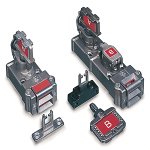HI guys I wanted to get some ideas. I am trying to figure out a way to lock out a machine with a trapped key setup that isolates power and drops out an MSR then only unlocks the doors when the key is removed then also somehow requires the operator to take the key without using an exchange station. The customer does not want to make the operator walk around to an exchange station but still ensure the key is a requirement to unlock the machine.
I have read alot of manufacturer info but don't think this is a possibility as the trapped key when turned off and removed would need a set of contacts or some other means to initiate a door unlock signal.
Any ideas?
I have read alot of manufacturer info but don't think this is a possibility as the trapped key when turned off and removed would need a set of contacts or some other means to initiate a door unlock signal.
Any ideas?
Last edited:







